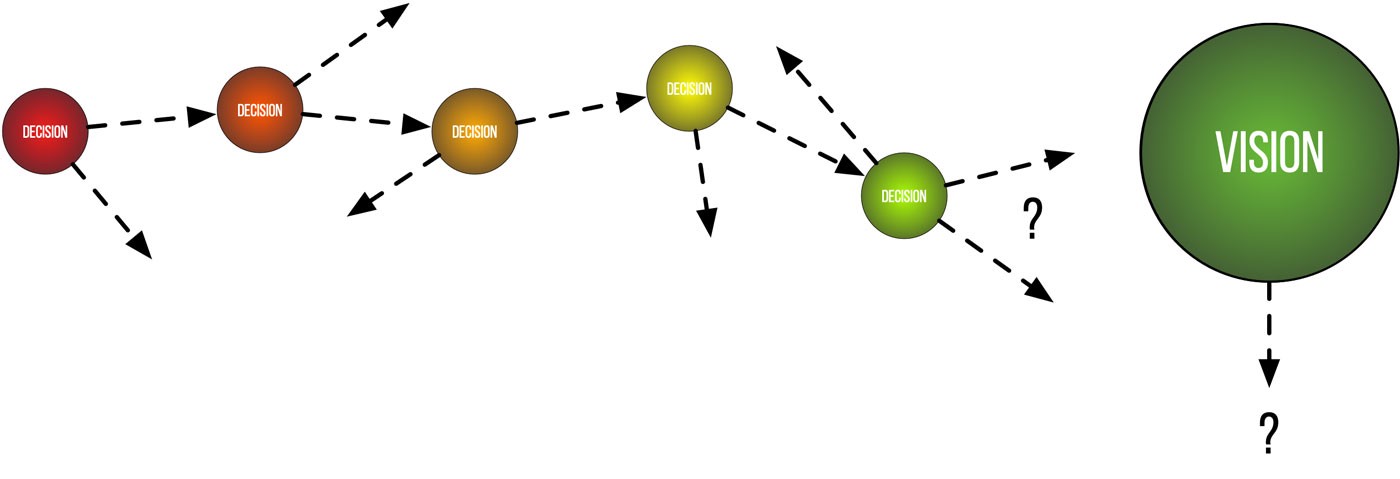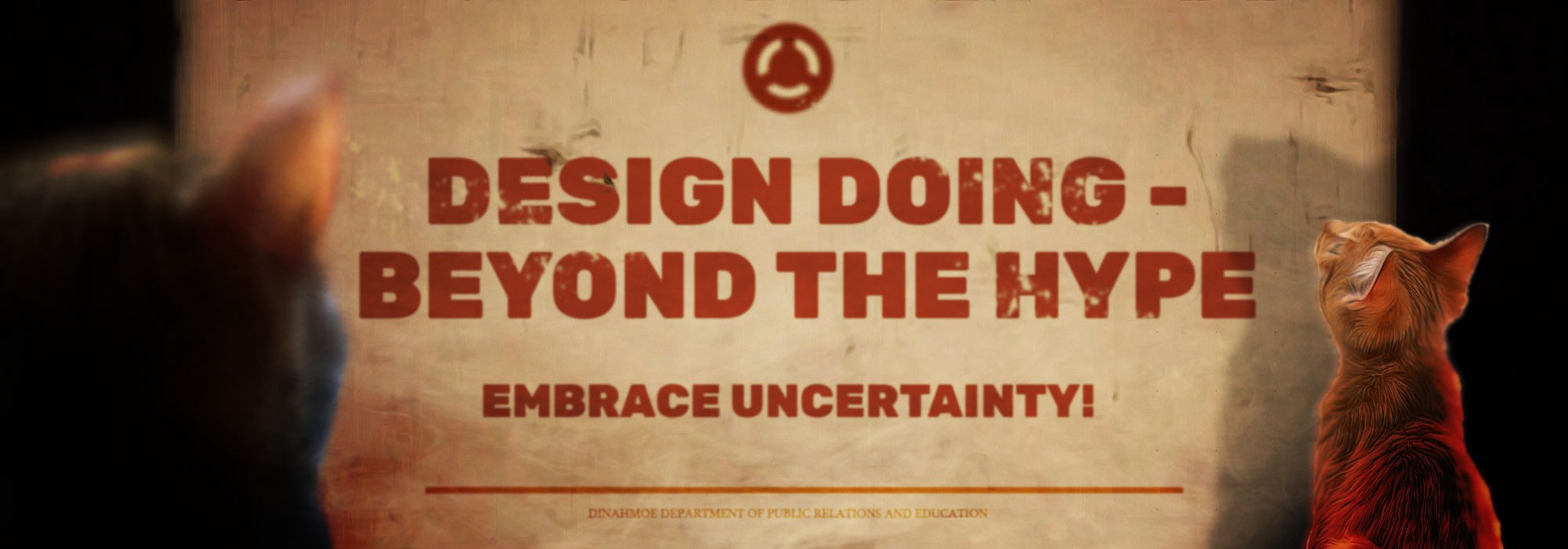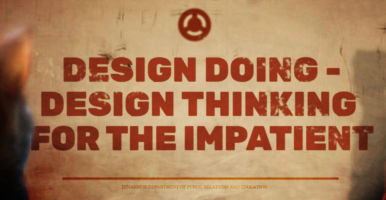Design Doing — Beyond the Hype
Embrace uncertainty!In an earlier article I brought up some issues that I have with Design Thinking, and presented my alternative, Design Doing. The name was chosen to poke fun at DT. The term is not new and I do not claim ownership in any way. But it has to have a name so Design Doing will have to do until someone (including me) comes up with a better one.
The method is no joke, it is real and proven in real world scenarios again and again, so here is the second article about Design Doing.
So what is Design Doing? Here is the process flow:

Obviously a very top level description so let’s pick it apart. But first we need to look at it in the right way., in a slightly blurry way.
We are experts in fooling ourselves
Our brains are constantly looking for patterns that helps us make sense of the world. This ability is very much involved in the creative process. A constant input of information is processed unconsciously, patterns emerge and ideas and solutions to our problems arise as out of nowhere.
The same creative super power is also messing things up. We see patterns where there are none, they are just the result of our wishful thinking. Last time I did this rain dance it saved my crops, so let’s do some dancing!
If we want to use our creative skills for something meaningful, then we’d better make sure that we rule out the rain dance as a solution. We need to guide our creative minds.
A blurry state of mind

I use the metaphor of vision for the process to get to a goal. Things that are close are clear and we can see all details. Things farther away becomes more blurry, only the larger shapes are discernible. Any predictions about the future will be done with insufficient data, and the outcome of any decisions will be uncertain.
Since uncertainty is inevitable we need to let go of our need for control and embrace it. Think about everything in terms of probabilities, what is the chance in percentage of something happening (or not).
Putting a number on it makes us aware of that there are other options and alternatives. It is actually very few things that are 100% certain, even what we take for granted is only just very very VERY likely.
That doesn’t mean that we shouldn’t make predictions and decision, quite the opposite, as long as we make them with the probabilities in mind. This will make us much less likely to run full speed in the wrong direction.
And since the future is more or less blurry, we need to be prepared to change our minds at any time. Maybe we think we have it all figured out. That will make us both blind and deaf for signals that we are on the wrong track. When we finally notice we might be too far down the road, or have an emotional attachment to the solution that makes us stick to it, no matter what.
An iterative process
Everyone talks about an iterative process. Waterfall is supposed to be dead, at least no one adheres to it publicly, still I see it everywhere, even in Design Thinking (I am sure some will disagree, there is a comments section for that 🙂).
Design Doing embraces iterative in all stages, it actually requires the process to be iterative. During the process we will redefine problems, find new ones, see new opportunities, maybe even redefine the very first step, the innovation trigger, since we might learn that there was a better opportunity.

Are you capable to embrace that level of uncertainty? Cool, let’s dig in!
Step 1: If something feels complicated…
If reality moves along according to plan then all is well but if something feels complicated… Step 1 in the creative process is to listen to that little voice that says: “there must be a better way”.

I call this the Innovation Trigger. It makes you aware that there is an opportunity to innovate!
It doesn’t have to be your own reality that feels complicated. Anyone can bring up a problem where the existing solutions feel complicated. It is up to you as a Design Doer to notice the trigger, the opportunity to innovate.
If the reality is not familiar to you, then some research might be needed. I say “might” since it totally depends on the challenge. Sometimes there is a great body of work to learn from, sometimes understanding the “wrong” solutions doesn’t help at all. Sometimes the users know exactly what they need, and sometimes they are way off.
Be open minded and stay honest!
Step 2: The solution
Step 2 is to envision how it should be, how it should work. What would the perfect version of this be? In many cases you probably have an idea of how that might look like.
Make this idea as clear as possible, use whatever tools you need to visualize the idea and make it concrete. This will help us find any obvious road blocks and potential work arounds.

If the ideal solution survives the concretization, try it on others. Is it a vision worth pursuing? Does it hold up to scrutiny? Always remember that users don’t always know what they want and need until it is real. This can result in both overly positive and negative feedback.
Having a vision is essential for the process to work. Without a vision there is no compass, no direction, no way to judge progress as we will see in step 4. It is equally essential to acknowledge that we are in the middle of a process. The vision is the most probable one, but it is still a theory until it is proven, and can change at any time if reality shows us a better one.
So keep it blurry. Don’t try to define details that should be handled at a later stage in the process.
Step 3: What is holding us back?
Step 3 is to identify what holds reality back from not already being at the goal, having our vision implemented. What are the problems that, if solved, would allow the goal to become reality? Please note that the problems themselves are not the focus, they are just there to be solved.

Problems can be one or many depending on the complexity, e.g. you have lost your keys or want to solve global warming.
Once again, keep it blurry. Only define problems that you think are probable and need to be solved. Take note but don’t address problems that you think are of less importance or better handled in the future. Problems are often intertwined and solving one problem can fundamentally change or even solve another. Solving complex problems always start with finding where to start untangling the mess.
Also keep in mind that Design Doing is an iterative process. The list of problems will be in constant change. A problem can lead to a revisit of the vision, or it might even require an update of reality 😜.
Step 4: check off the list
Step 4 is to solve the problems one by one and check them off the list. For every problem solved you get closer to the goal. Prototypes and testing should be used when needed.

This is where the vision is so essential. There could be a million decision points on the way. Use the vision as a compass to judge whether solving one of the problems brings you closer or not. If the decision gets you closer to the vision, then you are probably on the right track.

At points in the process you will have decision points where one of the alternatives suggests a new vision, a better, faster, cheaper, or sexier vision.
This is when the value of keeping a blurry state of mind becomes clear. It was simply not possible to see the new vision from the beginning. The only way to get there was to follow the blurry rabbit, be open minded, stay honest and trust the process.
Step 5
And when you have solved all the problems, then you are at step 5 and have arrived!

But are we ever satisfied? Of course not! Life is an iterative process!
Which I will describe in part 3, stay tuned!




